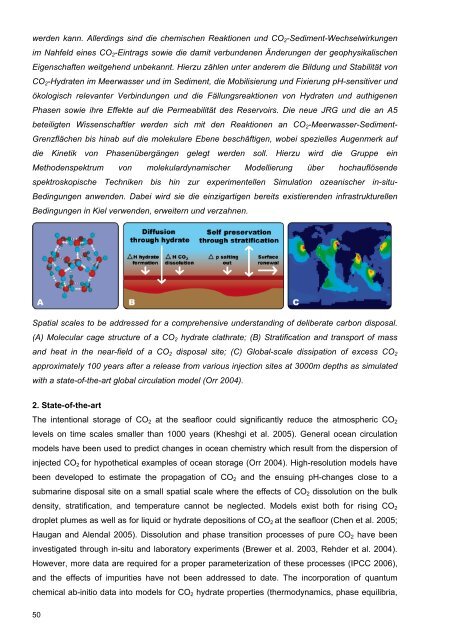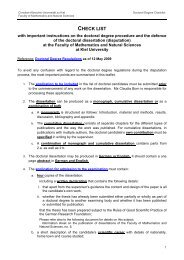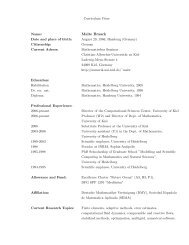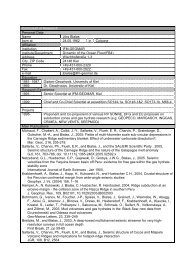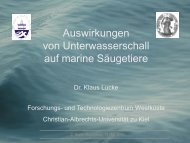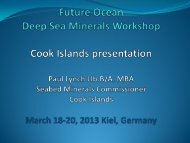Untitled - The Future Ocean
Untitled - The Future Ocean
Untitled - The Future Ocean
- No tags were found...
You also want an ePaper? Increase the reach of your titles
YUMPU automatically turns print PDFs into web optimized ePapers that Google loves.
werden kann. Allerdings sind die chemischen Reaktionen und CO 2 -Sediment-Wechselwirkungenim Nahfeld eines CO 2 -Eintrags sowie die damit verbundenen Änderungen der geophysikalischenEigenschaften weitgehend unbekannt. Hierzu zählen unter anderem die Bildung und Stabilität vonCO 2 -Hydraten im Meerwasser und im Sediment, die Mobilisierung und Fixierung pH-sensitiver undökologisch relevanter Verbindungen und die Fällungsreaktionen von Hydraten und authigenenPhasen sowie ihre Effekte auf die Permeabilität des Reservoirs. Die neue JRG und die an A5beteiligten Wissenschaftler werden sich mit den Reaktionen an CO 2 -Meerwasser-Sediment-Grenzflächen bis hinab auf die molekulare Ebene beschäftigen, wobei spezielles Augenmerk aufdie Kinetik von Phasenübergängen gelegt werden soll. Hierzu wird die Gruppe einMethodenspektrum von molekulardynamischer Modellierung über hochauflösendespektroskopische Techniken bis hin zur experimentellen Simulation ozeanischer in-situ-Bedingungen anwenden. Dabei wird sie die einzigartigen bereits existierenden infrastrukturellenBedingungen in Kiel verwenden, erweitern und verzahnen.Spatial scales to be addressed for a comprehensive understanding of deliberate carbon disposal.(A) Molecular cage structure of a CO 2 hydrate clathrate; (B) Stratification and transport of massand heat in the near-field of a CO 2 disposal site; (C) Global-scale dissipation of excess CO 2approximately 100 years after a release from various injection sites at 3000m depths as simulatedwith a state-of-the-art global circulation model (Orr 2004).2. State-of-the-art<strong>The</strong> intentional storage of CO 2 at the seafloor could significantly reduce the atmospheric CO 2levels on time scales smaller than 1000 years (Kheshgi et al. 2005). General ocean circulationmodels have been used to predict changes in ocean chemistry which result from the dispersion ofinjected CO 2 for hypothetical examples of ocean storage (Orr 2004). High-resolution models havebeen developed to estimate the propagation of CO 2 and the ensuing pH-changes close to asubmarine disposal site on a small spatial scale where the effects of CO 2 dissolution on the bulkdensity, stratification, and temperature cannot be neglected. Models exist both for rising CO 2droplet plumes as well as for liquid or hydrate depositions of CO 2 at the seafloor (Chen et al. 2005;Haugan and Alendal 2005). Dissolution and phase transition processes of pure CO 2 have beeninvestigated through in-situ and laboratory experiments (Brewer et al. 2003, Rehder et al. 2004).However, more data are required for a proper parameterization of these processes (IPCC 2006),and the effects of impurities have not been addressed to date. <strong>The</strong> incorporation of quantumchemical ab-initio data into models for CO 2 hydrate properties (thermodynamics, phase equilibria,50


